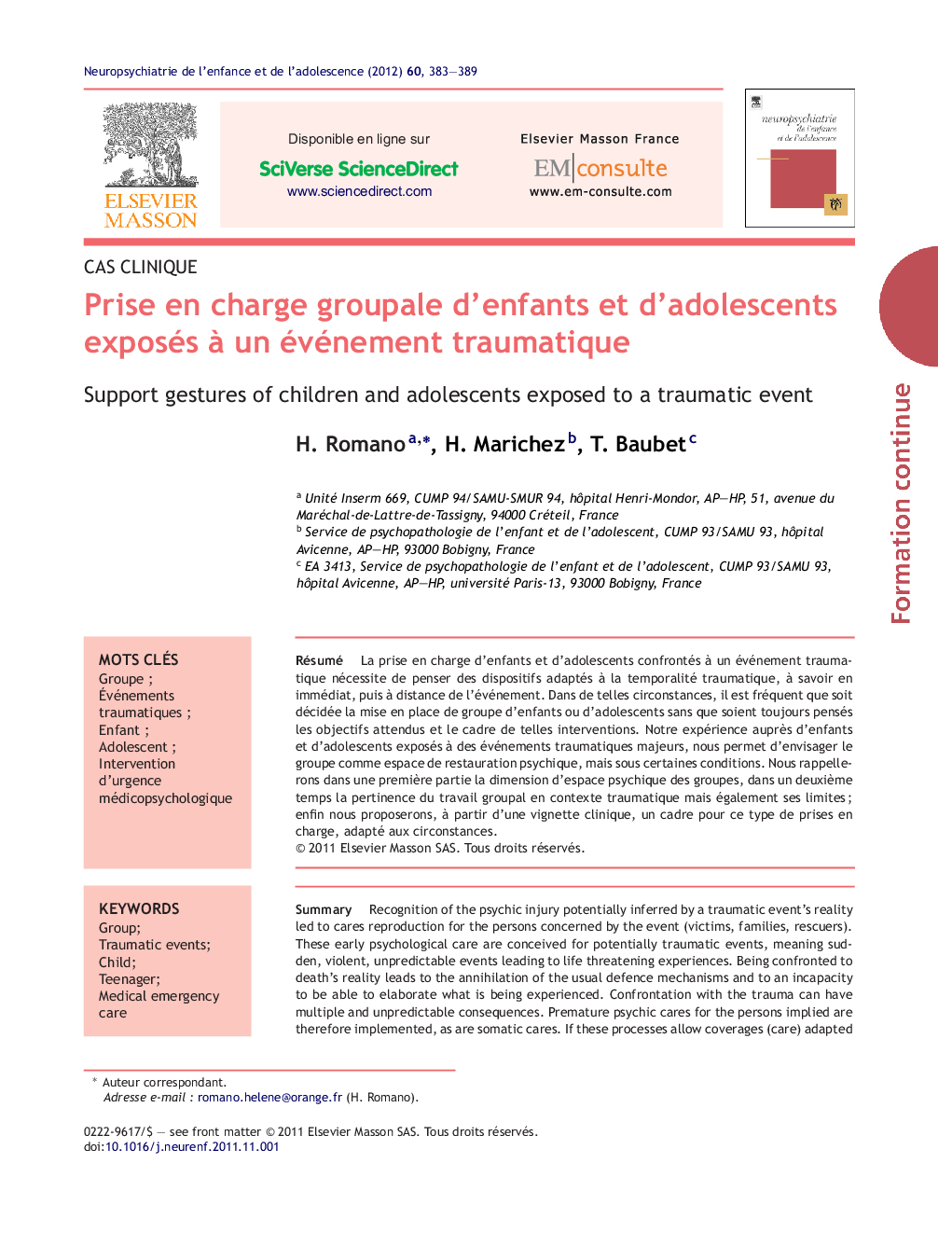| کد مقاله | کد نشریه | سال انتشار | مقاله انگلیسی | نسخه تمام متن |
|---|---|---|---|---|
| 943992 | 925577 | 2012 | 7 صفحه PDF | دانلود رایگان |

RésuméLa prise en charge d’enfants et d’adolescents confrontés à un événement traumatique nécessite de penser des dispositifs adaptés à la temporalité traumatique, à savoir en immédiat, puis à distance de l’événement. Dans de telles circonstances, il est fréquent que soit décidée la mise en place de groupe d’enfants ou d’adolescents sans que soient toujours pensés les objectifs attendus et le cadre de telles interventions. Notre expérience auprès d’enfants et d’adolescents exposés à des événements traumatiques majeurs, nous permet d’envisager le groupe comme espace de restauration psychique, mais sous certaines conditions. Nous rappellerons dans une première partie la dimension d’espace psychique des groupes, dans un deuxième temps la pertinence du travail groupal en contexte traumatique mais également ses limites ; enfin nous proposerons, à partir d’une vignette clinique, un cadre pour ce type de prises en charge, adapté aux circonstances.
SummaryRecognition of the psychic injury potentially inferred by a traumatic event's reality led to cares reproduction for the persons concerned by the event (victims, families, rescuers). These early psychological care are conceived for potentially traumatic events, meaning sudden, violent, unpredictable events leading to life threatening experiences. Being confronted to death's reality leads to the annihilation of the usual defence mechanisms and to an incapacity to be able to elaborate what is being experienced. Confrontation with the trauma can have multiple and unpredictable consequences. Premature psychic cares for the persons implied are therefore implemented, as are somatic cares. If these processes allow coverages (care) adapted to the clinical demonstrations (appearances) of the psychic injured (wounded) persons, they can lead (drive) to multiple drift of which their use for not traumatic facts. The current situation is paradoxical: on one side there is a bigger recognition of the reality of the psychic wounds and the potential consequences caused by a traumatic event and of other, this systematic consideration leads to a collective identical demand of the traumatic fact transforming it into a political stake. The social and political recognition of the psychic traumatism is parallel to its instrumentalisation and exploitation. That leads inevitably to maintaining the subjects involved in a state of dependence, vulnerability and psychic incompetence, that of the victim. Support for children and adolescents faced a traumatic event requires thinking devices adapted to the traumatic temporality, namely in immediate, then the event remotely. In such circumstances, it is common that is decided the establishment of a group of children or adolescents that are always conceived the expected objectives and framework for such interventions. Our experience with children and adolescents exposed to major traumatic events, allows us to consider the group as a space of mental restoration, but under certain conditions. We will remember in the first part of the dimension of psychological space of the groups, in a second time the relevance of the traumatic context groupal work but also its limits. Finally we will propose, from a clinical example, a framework for this type of support adapted to the circumstances. Our references are these of René Kaës, for which, each group is, an era of “psychic work” between three spaces of psychic reality. Which brings us to consider the group as the post-traumatic psychic creativity, it is the spontaneous investment in children and in particular among adolescents, group, as soon as a traumatic event comes change their lives. It is also our experience with children and teenagers for which the Group was a real “potential era” where the restauration of their psychic abilities was made possible by labour psychic groupal. Beyond these findings, it is not encouraging at all costs to the systematic group supported following a traumatic event. Each situation remains singular and committed individual, groupal, institutional, specific stories. We know as “injunction” to the Group and group by untrained professionals animation effects and this situation make worst the disorders for children and adolescents. It is therefore necessary to propose a framework for intervention in this context, so that these supported could value the group and make a space of psychic care.
Journal: Neuropsychiatrie de l'Enfance et de l'Adolescence - Volume 60, Issue 5, July 2012, Pages 383–389